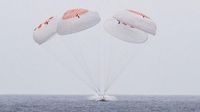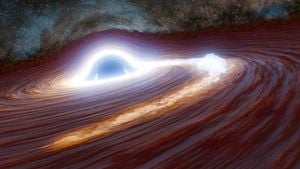After nearly five months orbiting high above Earth, four astronauts have returned safely, splashing down in the Pacific Ocean off California’s coast in a SpaceX Dragon capsule. Their homecoming on August 9, 2025, marks not only the conclusion of the 10th crew rotation mission to the International Space Station (ISS) under NASA’s Commercial Crew Program, but also a testament to the reliability of commercial partnerships in space travel, as reported by multiple outlets including BBC and ABP Live.
The returning crew—NASA’s Anne McClain and Nichole Ayers, Takuya Onishi from the Japan Aerospace Exploration Agency (JAXA), and Russia’s Kirill Peskov—had launched in March 2025 with a clear mission: relieve two NASA astronauts unexpectedly stranded on the ISS after a Boeing Starliner malfunctioned. Their journey home, which began with undocking from the ISS at 22:15 GMT on August 8, was not without suspense. The capsule’s 17-hour descent, slowed first by the friction of atmospheric re-entry and then by massive parachutes, ended with a gentle splashdown at 8:44 a.m. local time (15:34 GMT) off the Southern California coast, as confirmed by both NASA and SpaceX updates.
“From the entire Crew-10, thank you,” radioed Anne McClain, the mission commander, moments after landing. “It was truly the ride of a lifetime.” Her words, relayed by ABP Live, captured the relief and exhilaration of returning to Earth after months in microgravity.
The astronauts’ return was the final step in a carefully choreographed exchange. When Crew-10 launched aboard a SpaceX Falcon 9 rocket on March 14, 2025, they were stepping into a unique situation. Two NASA astronauts, Butch Wilmore and Sunita Williams, had been marooned on the ISS for nine months—far longer than their planned eight-day test flight—after the Boeing Starliner’s propulsion system developed problems. Crew-10’s arrival allowed Wilmore and Williams to hand over ISS duties and focus on resolving the technical issues with their spacecraft, according to BBC and ABP Live.
The timing of the Crew-10 return was itself a product of the unpredictable nature of spaceflight. Originally scheduled for Thursday, the splashdown was delayed due to poor weather at the recovery site, forcing the crew to remain in orbit a little longer. When conditions finally cleared, the Dragon capsule undocked from the ISS on Friday evening, embarking on its 17.5-hour journey home. The spacecraft’s heat shield endured searing temperatures during re-entry, before the deployment of four large parachutes slowed the capsule for a safe, ocean landing. SpaceX recovery teams quickly hoisted the capsule onto a ship, where the astronauts were able to breathe Earth’s air for the first time in months.
During their time on the ISS, the Crew-10 astronauts were anything but idle. They conducted hundreds of scientific experiments and technology demonstrations, focusing on areas like biology, material science, and human physiology. Among their research were studies on plant growth and how cells respond to gravity, as well as the production of proteins in microalgae under microgravity. These experiments are considered critical for preparing future long-duration missions to the Moon, Mars, and possibly beyond, as highlighted by ABP Live.
“The experiments we conducted will help pave the way for humanity’s next giant leap,” said Nichole Ayers, NASA pilot, in a statement released by NASA. While the official quotes were brief, the sentiment echoed throughout the mission: this was about more than just coming and going from the ISS—it was about building the knowledge and technology for humanity’s future in space.
The successful conclusion of Crew-10’s mission also underscored the growing role of private industry in spaceflight. SpaceX’s Crew Dragon has become a workhorse for NASA, reliably ferrying astronauts to and from the ISS. The Commercial Crew Program, launched in the wake of the Space Shuttle’s retirement, was designed to foster just this kind of public-private partnership. As BBC reported, the Dragon’s safe return is further evidence that the model is working.
Yet, the mission’s context was shaped by the ongoing challenges faced by other commercial providers. The Boeing Starliner’s propulsion issues, which stranded Wilmore and Williams for nine months, served as a stark reminder that space travel is never routine. NASA announced this week that Wilmore, a veteran astronaut with 25 years of service, has decided to retire—a move that marks the end of an era for the agency and highlights the ever-changing roster of those who venture into orbit.
Meanwhile, the rhythm of life aboard the ISS continues. On August 3, 2025, just days before Crew-10’s return, a new international team arrived for a six-month stint: NASA’s Zena Cardman and Mike Fincke, JAXA’s Kimiya Yui, and Russian cosmonaut Oleg Platonov. The handoff from Crew-10 to this new crew ensures that the ISS remains continuously staffed, a tradition that has endured for over two decades.
The Crew-10 mission also highlighted the importance of international cooperation in space. With astronauts from the US, Japan, and Russia working side by side, the ISS remains a rare example of global collaboration, even as tensions simmer on the ground. The seamless teamwork on display during Crew-10’s stay—whether conducting experiments, maintaining the station, or handling the logistics of crew rotations—serves as a quiet rebuke to the notion that space exploration must be a solitary pursuit.
The astronauts’ safe return was celebrated by all partners involved. “Welcome home,” SpaceX Mission Control radioed as the capsule floated in the Pacific, a simple message carrying the weight of months of planning, risk, and anticipation. For the astronauts themselves, the moment was bittersweet. As McClain noted, “It’s good to be home, but a part of me will always look up at the night sky and remember what it felt like to be up there.”
As Crew-10’s journey comes to a close, attention now turns to the next chapter in human spaceflight. With new crews already aboard the ISS and ongoing efforts to resolve technical challenges with Boeing’s Starliner, the story of international cooperation and commercial innovation in orbit continues. The lessons learned from Crew-10’s mission—both scientific and operational—will shape the future of space exploration for years to come.
For now, though, four astronauts are back on Earth, carrying with them the memories of nearly five months among the stars, and the knowledge that their work has brought humanity one step closer to the next frontier.




